|
|
|
Sort Order |
|
|
|
Items / Page
|
|
|
|
|
|
|
| Srl | Item |
| 1 |
ID:
117261


|
|
|
|
|
| Publication |
2013.
|
| Summary/Abstract |
The power crisis problem is getting worse in the developing countries. Measures are being taken to overcome the power shortage problem by efficiently utilizing the available power. Replacement of high-power consumption lamps with energy efficient lamps is also among these steps. This paper presents a detailed comparative analysis between domestic lighting lamps (DLLs) use for producing artificial light. DLLs include incandescent lamp (IL), fluorescent lamp (FL) and compact fluorescent lamp (CFL). Light emitting diodes (LED) based lamp technology is relatively new in comparison with conventional incandescent and discharge lamps. However, the present study will also cover the LED lamps. Power quality based experiments have been conducted on DLLs in Power System Laboratory and power consumption based calculations are carried out using the lighting design software DIALux. The result shows that with the current technology, the use of FL and LED lamp is beneficial for utility as well as for consumer. However, with the current pace in the development of LED technology, it is possible LED lamps will lead the lighting market in the near future. The paper has also presented the uncertainties that exist in lighting market and proposed the guidelines that will help in making future energy policy.
|
|
|
|
|
|
|
|
|
|
|
|
|
|
|
|
| 2 |
ID:
121311


|
|
|
|
|
| Publication |
2013.
|
| Summary/Abstract |
Biogas production processes are often multifunctional systems, which also produce fertilizers from digested sludge. The environmental impacts of such systems are usually determined using life cycle assessment (LCA). There are alternative approaches to conduct the LCA, e.g., allocation of emissions based on a product's and co-product's energy content according to the Renewable Energy Directive (RED), or substitution without allocation according to the ISO 14040 standard. We calculated the climate change impacts of biogas production using these two alternative methods, whilst also considering process modifications of the base case biogas production process. The aim was to find out whether the production system achieves the saving targets for greenhouse gas (GHG) emissions set by the RED. Since the RED enables different interpretations of its calculation rules, we created four case studies representing alternative ways to allocate the emissions to the reject water and solid fractions separated from the sludge. Consequently, our emission estimates for the base case vary between 16.9 and 47.7 g CO2/MJ, while the emission savings range from 42% to 80%. Most of the case studies achieved the most stringent saving target (60%).
|
|
|
|
|
|
|
|
|
|
|
|
|
|
|
|
| 3 |
ID:
128353


|
|
|
|
|
| Publication |
2014.
|
| Summary/Abstract |
The Colombian biofuels are used in the transportation sector at low-percentage blends of biofuel-fossil fuel (until 8:92, volume basis). Since energy policies encourage the increment of Bioenergy percentage in energy matrix, the biofuels production and use should be increased during the next years. In this work, the environmental assessment of several scenarios involving current and promising biofuel supply chains was made. The aim of this paper was the assessment of several possible alternatives to increase the biofuels production from current agricultural supply chains. Sugarcane, cassava, oil-palm and jatropha were considered as feedstocks for the analysis. The environmental assessment included calculations of the greenhouse gas emissions and the potential environmental impacts, using the life cycle assessment approach. The results indicated that the current biofuels production mitigates environmental impacts in comparison to fossil fuels production and use. Additionally, biofuels production using promising feedstocks could be environmentally competitive if the production processes are improved.
|
|
|
|
|
|
|
|
|
|
|
|
|
|
|
|
| 4 |
ID:
150800


|
|
|
|
|
| Summary/Abstract |
We performed a comprehensive and internally consistent assessment of the energy performance of the full range of electricity production technologies in the United Kingdom, integrating the viewpoints offered by net energy analysis (NEA) and life cycle assessment (LCA). Specifically, the energy return on investment (EROI), net-to-gross energy output ratio (NTG) and non-renewable cumulative energy demand (nr-CED) indicators were calculated for coal, oil, gas, biomass, nuclear, hydro, wind and PV electricity. Results point to wind, and to a lesser extent PV, as the most recommendable technologies overall in order to foster a transition towards an improved electricity grid mix in the UK, from both points of view of short-term effectiveness at providing a net energy gain to support the multiple societal energy consumption patterns, and long-term energy sustainability (the latter being inversely proportional to the reliance on non-renewable primary energy sources). The importance to maintain a sufficient installed capacity of readily-dispatchable gas-fired electricity is also recognised.
|
|
|
|
|
|
|
|
|
|
|
|
|
|
|
|
| 5 |
ID:
126517


|
|
|
|
|
| Publication |
2013.
|
| Summary/Abstract |
An ever-increasing body of research explores the effectiveness of Home Energy Management Systems (HEMS) in achieving energy savings in households. To date, however, the overall life cycle impact of the HEMS itself has not been taken into account. Thus, no assessment has been made whether the amount of energy saved (esaved) outweighs the energy needed for production, use and disposal (einvested). Therefore, an eco-cost and a Cumulative Energy Demand (CED) method were used to analyze three distinct types of HEMS. Based on the literature, six scenarios were developed in order to find the break-even point, where einvested=esaved. The results show that the overall impact is dependent on the type of HEMS, and that if the duration of use is short and the achieved savings are small, the benefits do not always outweigh the environmental costs. Care should be taken not to develop HEMS with unnecessarily elaborate parts or functionalities and that their own electricity consumption is minimized. The paper concludes by discussing the implication for polices concerning the implementation of smart meters and HEMS and their design.
|
|
|
|
|
|
|
|
|
|
|
|
|
|
|
|
| 6 |
ID:
127515
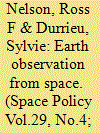

|
|
|
|
|
| Publication |
2013.
|
| Summary/Abstract |
Remote sensing scientists work under assumptions that should not be taken for granted and should, therefore, be challenged. These assumptions include the following:
1. Space, especially Low Earth Orbit (LEO), will always be available to governmental and commercial space entities that launch Earth remote sensing missions.
2. Space launches are benign with respect to environmental impacts.
3. Minimization of Type 1 error, which provides increased confidence in the experimental outcome, is the best way to assess the significance of environmental change.
4. Large-area remote sensing investigations, i.e. national, continental, global studies, are best done from space.
5. National space missions should trump international, cooperative space missions to ensure national control and distribution of the data products.
At best, all of these points are arguable, and in some cases, they're wrong. Development of observational space systems that are compatible with sustainability principles should be a primary concern when Earth remote sensing space systems are envisioned, designed, and launched. The discussion is based on the hypothesis that reducing the environmental impacts of the data acquisition step, which is at the very beginning of the information stream leading to decision and action, will enhance coherence in the information stream and strengthen the capacity of measurement processes to meet their stated functional goal, i.e. sustainable management of Earth resources. We suggest that unconventional points of view should be adopted and when appropriate, remedial measures considered that could help to reduce the environmental footprint of space remote sensing and of Earth observation and monitoring systems in general. This article discusses these five assumptions in the context of sustainable management of Earth's resources. Taking each assumption in turn, we find the following:
(1) Space debris may limit access to Low Earth Orbit over the next decades.
(2) Relatively speaking, given that they're rare event, space launches may be benign, but study is merited on upper stratospheric and exospheric layers given the chemical activity associated with rocket combustion by-products.
(3) Minimization of Type II error should be considered in situations where minimization of Type I error greatly hampers or precludes our ability to correct the environmental condition being studied.
(4) In certain situations, airborne collects may be less expensive and more environmentally benign, and comparative studies should be done to determine which path is wisest.
(5) International cooperation and data sharing will reduce instrument and launch costs and mission redundancy. Given fiscal concerns of most of the major space agencies - e.g. NASA, ESA, CNES - it seems prudent to combine resources.
|
|
|
|
|
|
|
|
|
|
|
|
|
|
|
|
| 7 |
ID:
124188


|
|
|
|
|
| Publication |
2013.
|
| Summary/Abstract |
The entire life cycle of a municipal solid waste (MSW) oxy-fuel incineration power plant was evaluated using the method of life cycle assessment (LCA) to identify and quantify the fossil energy requirements and environmental impacts. The functional unit was 1000 kg (1 t) MSW. During the life cycle, the saving standard coal by electricity generation was more than diesel consumption, and the effect of soot and ashes was the greatest among all calculated categorization impacts. The total weighted resource consumption and total weighted environment potential of MSW oxy-fuel incineration were ?0.37 mPR90 (milli person equivalent) and ?0.27 PET2010 (person equivalent), better than MSW incineration with CO2 capture via monoethanolamine (MEA) absorption. The sensitivity analysis showed that the electric power consumption of air separation unit (ASU) was the primary influencing parameter, and the influence of electric power consumption of CO2 compressor was secondary, while transport distance had small influence. Overall, MSW oxy-fuel incineration technology has certain development potential with the increment of MSW power supply efficiency and development of ASU in the future.
|
|
|
|
|
|
|
|
|
|
|
|
|
|
|
|
| 8 |
ID:
113425
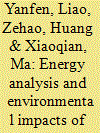

|
|
|
|
|
| Publication |
2012.
|
| Summary/Abstract |
The entire life cycle of biodiesel produced by microalgal biomasses was evaluated using the method of life cycle assessment (LCA) to identify and quantify the fossil energy requirements and environmental impact loading of the system. The life cycle considers microalgae cultivation, harvesting, drying, oil extraction, anaerobic digestion, oil transportation, esterification, biodiesel transportation and biodiesel combustion. The investigation results show that the fossil energy requirement for the biodiesel production is 0.74 MJ/MJ biodiesel, indicating that 1 MJ of biodiesel requires an input of 0.74 MJ of fossil energy. Accordingly, biodiesel production is feasible as an energy producing process. The environmental impact loading of microalgal biodiesel is 3.69 PET2010 (Person Equivalents, Targeted, in 2010) and the GWP is 0.16 kg CO2-eq/MJ biodiesel. The effects of photochemical ozone formation were greatest among all calculated categorization impacts. The fossil energy requirement and GWP in this operation were found to be particularly sensitive to oil content, drying rate and esterification rate. Overall, the results presented herein indicate that the cultivation of microalgae has the potential to produce an environmentally sustainable feedstock for the production of biodiesel.
|
|
|
|
|
|
|
|
|
|
|
|
|
|
|
|
| 9 |
ID:
150743


|
|
|
|
|
| Summary/Abstract |
Despite significant public attentions to green supply chain management, few studies have explicitly addressed the energy implications of consumer-goods supply surplus, especially in developing countries like China. This study explored the energy-saving potential from improving supply chain efficiencies and reducing excess inventory in China's retail system from a life-cycle perspective. Through embodied energy analysis, we found that energy invested pre-manufacture contributed 80–95% of the total energy embodied in consumer products. Although embodied energy intensities had declined by 60–90% since the mid-1990s, the lessened marginal improvements implied that "low hanging fruits" have largely been captured, and the search for new opportunities for energy-saving is in demand. Positive correlations between total economic inputs and embodied energy in consumer goods indicated possible synergy effect between cost-reduction and energy-saving in supply system management. And structural path analysis identified sector-specific energy management priorities for each retail-related sector. This study suggested that improving supply chain efficiencies provides a promising supplement to China's current industrial energy-efficient projects which target reducing direct energy use per se as an intra-firm cost-saving measure. From the life-cycle perspective, the definition of "green sector" might have to be reconsidered in China towards a more energy-efficient economy and society.
|
|
|
|
|
|
|
|
|
|
|
|
|
|
|
|
| 10 |
ID:
101507
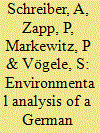

|
|
|
|
|
| Publication |
2010.
|
| Summary/Abstract |
This paper combines an existing projection of the development of electricity production with a technology-specific environmental assessment. The combination of these two approaches, which so far have only been performed separately, allows a discussion about environmental effects of carbon capture and storage (CCS) implementation strategies on a national level. The results identify the future role of lignite and hard coal in German power production. The implementation of CCS technology leads to a considerable loss of efficiency. Due to CCS, about 50 million t of lignite will be additionally required in 2030 in comparison to the reference case without CCS in 2010. Increasing demand, the replacement of old plants and the compensation of efficiency losses lead to highly ambitious expansion rates. In the case of CCS implementation, the global warming potential (GWP) can be reduced by up to 70%. However, other environmental impacts increase in part considerably. Compliance with national ceilings for NOx emissions can only be reached by compensation measures in other sectors. The results of the environmental assessment demonstrate the significant role of the coal composition, coal origin and the required transport. CO2 pipeline transport and CO2 storage make a fairly minor contribution to the overall environmental impact.
|
|
|
|
|
|
|
|
|
|
|
|
|
|
|
|
| 11 |
ID:
098601
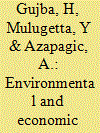

|
|
|
|
|
| Publication |
2010.
|
| Summary/Abstract |
The power sector in Nigeria is undergoing structural reforms aimed at improving and expanding the current grid generation capacity and distribution network. The Government has injected huge funds into this sector while also granting licences to private companies for the provision of electricity. It is also aiming to increase electricity generation capacity to 25,000 MW by 2020 from the current installed capacity of 6500 MW while also pledging to connect 75% of the population to the grid from the current 40% by 2025. This paper sets out to analyse the implications of the energy policy in Nigeria and presents the life cycle environmental and economic analysis of the current and future electricity sector. The results show that all the life cycle impacts and economic costs increase significantly over the time-period (2003-2030), but at different rates depending on the types of technologies deployed. Renewables such as large hydro and solar proposed by the Government have a potential to reduce the overall life cycle environmental impacts from the electricity mix, considering their lower environmental impacts compared to fossil-fuels. However, this requires a five-fold increase in grid investments from the current US$1.7 billion per year to US$9.40 billion by 2030.
|
|
|
|
|
|
|
|
|
|
|
|
|
|
|
|
| 12 |
ID:
112327


|
|
|
|
|
| Publication |
2012.
|
| Summary/Abstract |
The goal of this study is to evaluate the life cycle performance of two alternative pathways to biofuels in the shipping industry: the 'diesel route' and the 'gas route'. The diesel route comprises of a shift from heavy fuel oil to marine gas oil and then a gradual shift to biodiesel, whereas the gas route comprises of a shift to liquefied natural gas and then a gradual shift to liquefied biogas. The two routes are assessed in a case study for the ferry traffic between the Swedish mainland and the island Gotland. Life cycle assessment (LCA) is used to evaluate the environmental performance with the functional unit chosen to be one year of ro-pax ferry service, including both passenger and goods transportation. The gas route is indicated to have better overall environmental performance than the diesel route. Furthermore, use of biofuels is illustrated as one possible measure to decrease the global warming impact from shipping, but to the expense of greater environmental impact for some other impact categories. As an example, the global warming potential (GWP100) was shown to decrease with the use of biofuels in this study, while the eutrophication potential and the primary energy use increased.
|
|
|
|
|
|
|
|
|
|
|
|
|
|
|
|
| 13 |
ID:
171513
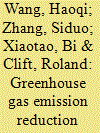

|
|
|
|
|
| Summary/Abstract |
The Canadian province of British Columbia (BC) provides an informative case study of bioenergy development, because it relies heavily on fossil fuels but has enormous bioenergy potential. We have examined the potential contribution of bioenergy to reducing BC's GHG emissions. The approach of combining life cycle assessment and economic evaluation to prioritize options should be applicable generally. Biomass availability, including forestry resources, agricultural waste and municipal solid waste, is estimated. Through simplified Life Cycle Assessment, GHG reduction potential of biogas, bioethanol, biofuels from hydrothermal liquefaction, and district heating are quantified, along with the associated GHG reduction costs. The analysis shows that existing biomass resources could yield 110–176 PJ per year, reducing GHG emissions by 13.0–15.7%. Bioenergy from waste streams is already cost-effective and should be prioritized in the short term. However, bioenergy from forestry resources, especially conversion to liquid biofuels, is prohibitively expensive, with GHG reduction cost exceeding CAD $300/t CO2-eq. The total extra cost required to achieve full utilization of BC's biomass resources is estimated as 0.8–2.4 billion dollars. To close the cost gaps between bioenergy and fossil fuels, both technological improvement and external cost adjustment through measures like carbon taxation will be needed.
|
|
|
|
|
|
|
|
|
|
|
|
|
|
|
|
| 14 |
ID:
098586


|
|
|
|
|
| Publication |
2010.
|
| Summary/Abstract |
Despite recent consumption decrease due to recession, European electricity sector is struggling to reach ambitious targets for reductions of greenhouse gas emissions. Our objective is to carry out a macro analysis of the energy mix in two European countries: Belgium and Spain. Life Cycle Assessments are carried for 2005 as well as for seven possible referenced scenarios to reach EU and also national legal objectives at the horizon 2020 and 2030. Ambitious renewable energy sources' deployment plans can decrease impacts on the environment significantly as those sources replace polluting traditional sources, such as coal/lignite, oil or gas. When concentrating on projections for the future in Spain, results show that a mix with little coal and oil replaced by up to 54% of RES-E energy sources could bring environmental benefits with CO2 emissions equivalent around 0.2 kg per kWh produced (compared with 0.54 kg in 2005). In Belgium, all future scenarios presented include more coal and gas with a limited share of RES-E; those mixes present more environmental harmful impacts (up to 0.56 kg CO2 equivalent). This is why RES-E deployment is crucial as long as it is part of an electricity mix with reduced quantities of traditional fossil fuels.
|
|
|
|
|
|
|
|
|
|
|
|
|
|
|
|
| 15 |
ID:
127202


|
|
|
|
|
| Publication |
2014.
|
| Summary/Abstract |
The present work aims to examine the strategic decision of future electricity generation mix considering, together with all other factors, the effect of the external cost associated with the available power generation technology options, not only during their operation but also during their whole life cycle. The analysis has been performed by integrating the Life Cycle Assessment concept into a linear programming model for the yearly decisions on which option should be used to minimize the electricity generation cost. The model has been applied for the case of Greece for the years 2012-2050 and has led to several interesting results. Firstly, most of the new generating capacity should be renewable (mostly biomass and wind), while natural gas is usually the only conventional fuel technology chosen. If externalities are considered, wind energy increases its share and hydro-power replaces significant amounts of biomass-generated energy. Furthermore, a sensitivity analysis has been performed. One of the most important findings is that natural gas increases its contribution when externalities are increased. Summing-up, external cost has been found to be a significant percentage of the total electricity generation cost for some energy sources, therefore significantly changing the ranking order of cost-competitiveness for the energy sources examined
|
|
|
|
|
|
|
|
|
|
|
|
|
|
|
|
| 16 |
ID:
124369


|
|
|
|
|
| Publication |
2013.
|
| Summary/Abstract |
We compare the potential of hybrid, extended-range plug-in hybrid, and battery electric vehicles to reduce lifetime cost and life cycle greenhouse gas emissions under various scenarios and simulated driving conditions. We find that driving conditions affect economic and environmental benefits of electrified vehicles substantially: Under the urban NYC driving cycle, hybrid and plug-in vehicles can cut life cycle emissions by 60% and reduce costs up to 20% relative to conventional vehicles (CVs). In contrast, under highway test conditions (HWFET) electrified vehicles offer marginal emissions reductions at higher costs. NYC conditions with frequent stops triple life cycle emissions and increase costs of conventional vehicles by 30%, while aggressive driving (US06) reduces the all-electric range of plug-in vehicles by up to 45% compared to milder test cycles (like HWFET). Vehicle window stickers, fuel economy standards, and life cycle studies using average lab-test vehicle efficiency estimates are therefore incomplete: (1) driver heterogeneity matters, and efforts to encourage adoption of hybrid and plug-in vehicles will have greater impact if targeted to urban drivers vs. highway drivers; and (2) electrified vehicles perform better on some drive cycles than others, so non-representative tests can bias consumer perception and regulation of alternative technologies. We discuss policy implications.
|
|
|
|
|
|
|
|
|
|
|
|
|
|
|
|
| 17 |
ID:
150921


|
|
|
|
|
| Summary/Abstract |
This paper presents for the first time an integrated life cycle sustainability assessment of the electricity sector in Turkey, considering environmental, economic and social aspects. Twenty life cycle sustainability indicators (11 environmental, three economic and six social) are used to evaluate the current electricity options. Geothermal power is the best option for six environmental impacts but it has the highest capital costs. Small reservoir and run-of-river power has the lowest global warming potential while large reservoir is best for the depletion of elements and fossil resources, and acidification. It also has the lowest levelised costs, worker injuries and fatalities but provides the lowest life cycle employment opportunities. Gas power has the lowest capital costs but it provides the lowest direct employment and has the highest levelised costs and ozone layer depletion. Given these trade-offs, a multi-criteria decision analysis has been carried out to identify the most sustainable options assuming different stakeholder preferences. For all the preferences considered, hydropower is the most sustainable option for Turkey, followed by geothermal and wind electricity. This work demonstrates the importance for energy policy of an integrated life cycle sustainability assessment and how tensions between different aspects can be reconciled to identify win-win solutions.
|
|
|
|
|
|
|
|
|
|
|
|
|
|
|
|
| 18 |
ID:
128341


|
|
|
|
|
| Publication |
2014.
|
| Summary/Abstract |
This study aimed at evaluating the co-benefit implications of alternative electricity generation scenarios in Japan, in a post-Fukushima context. Four scenarios were designed assuming different shares of energy sources in a 2030 timeframe. Applying a life cycle assessment (LCA) methodology, scenarios were assessed in terms of cumulative non-renewable energy (NRE) consumption, global warming potential (GWP), terrestrial acidification potential (TAP), and particulate matter formation (PMF). Additionally electricity generation costs were evaluated. Results demonstrate that the current dependence on fossil fuel is unfeasible in the long run, as it results in 14% higher NRE consumption, an increase of 32% on GHG emissions, 29% on TAP and 34% on PMF, and 9% higher cost than the baseline scenario under pre-Fukushima conditions. On the other hand, a share of up to 27% of renewable energies is technically possible and would result in a 34% reduction of NRE consumption, 29% decrease of GHG emissions, and contribute to the mitigation of 24% of TAP and PMF impacts, at minor increase of levelized costs. Increasing the share of renewables and phasing-out thermal power would therefore increase the resilience of the Japanese economy toward external oil markets, cope with environmental protection priorities, while promoting economic development.
|
|
|
|
|
|
|
|
|
|
|
|
|
|
|
|
| 19 |
ID:
127898


|
|
|
|
|
| Publication |
2014.
|
| Summary/Abstract |
This paper examined the potentialities of Life Cycle Assessment (LCA) as instrument for policy-support. To this respect, the adoption of an initiative within the Madrid Air Quality Plan (AQP) 2011-2015 regarding the substitution of diesel taxis with hybrid, natural gas and LPG alternatives was studied. Four different scenarios were elaborated, a business-as-usual scenario (BAU), the scenario of the AQP, and two extreme-situation scenarios: all-diesel (ADI) and all-ecologic (AEC). Impacts were characterized according to the ILCD methodology, focusing especially on climate change (CC) and photochemical ozone formation (PO). SimaPro 7.3 was used as analysis and inventory-construction tool. The results indicate that the shift to ecologic alternatives reduced impacts, especially those related to CC and PO. For the complete life cycle, reductions of 13% (CC) and 25% (PO) were observed for AQP against BAU (CC:1365 GgCO2, PO:13336 MgNMVOC). Deeper reductions were observed for AEC (CC:34%, PO:59%), while ADI produced slight increases in impacts if against BAU. The analysis of the use-phase revealed that the central and highest speed zones of the city benefit from the adoption of AQP. This is especially evident in zone 7, with reductions of 16% in CC and 31% in PO respectively against BAU (CCzone1:3443 kgCO2/veh·km, POzone7:11.1 kgNMVOC/veh·km).
|
|
|
|
|
|
|
|
|
|
|
|
|
|
|
|
| 20 |
ID:
125701
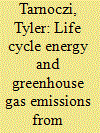

|
|
|
|
|
| Publication |
2013.
|
| Summary/Abstract |
Oil sands transportation diversification is important for preventing discounted crude pricing. Current life cycle assessment (LCA) models that assess greenhouse gas (GHG) emissions from crude oil transportation are linearly-scale and fail to account for project specific details. This research sets out to develop a detailed LCA model to compare the energy inputs and GHG emissions of pipeline and rail transportation for oil sands products. The model is applied to several proposed oils sands transportation routes that may serve as future markets. Comparison between transportation projects suggest that energy inputs and GHG emissions show a high degree of variation. For both rail and pipeline transportation, the distance over which the product is transported has a large impact on total emissions. The regional electricity grid and pump efficiency have the largest impact on pipeline emissions, while train engine efficiency and bitumen blending ratios have the largest impact on rail transportation emissions. LCA-based GHG regulations should refine models to account for the range of product pathways and focus efforts on cost-effective emission reductions. As the climate-change impacts of new oil sands transportation projects are considered, GHG emission boundaries should be defined according to operation control.
|
|
|
|
|
|
|
|
|
|
|
|
|
|
|
|
|
|
|
|
|